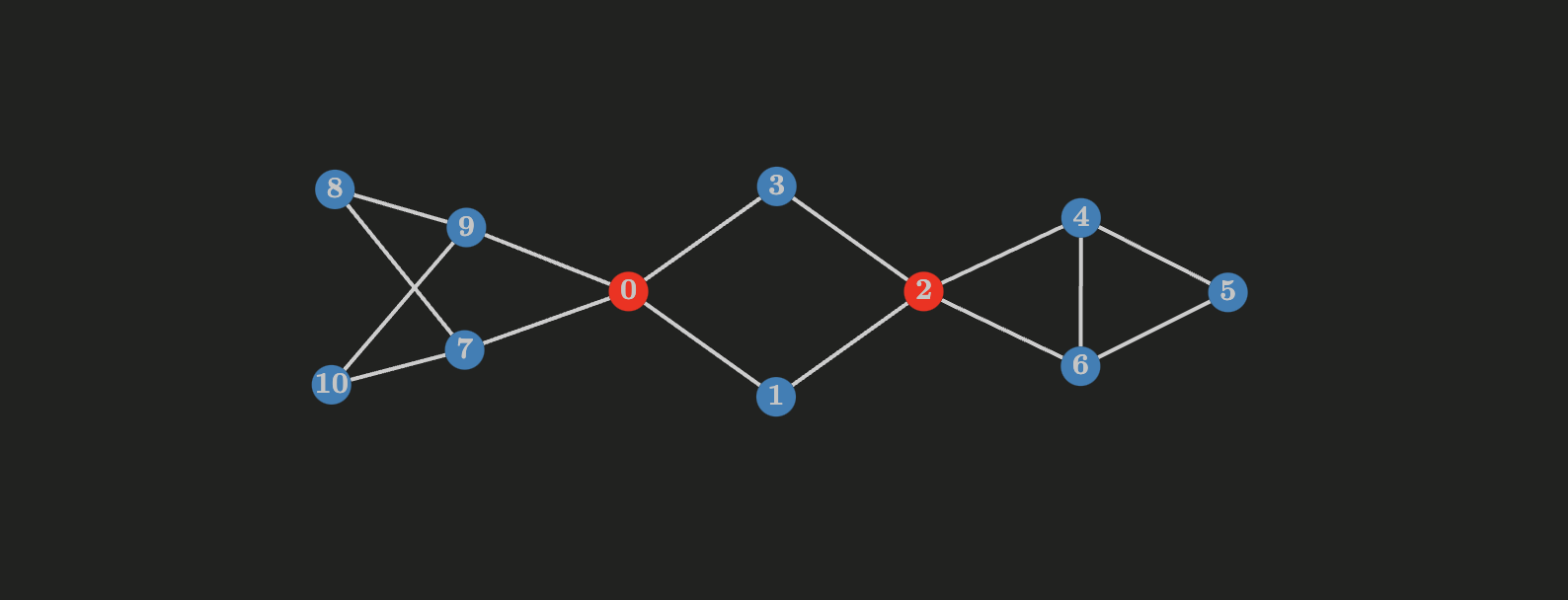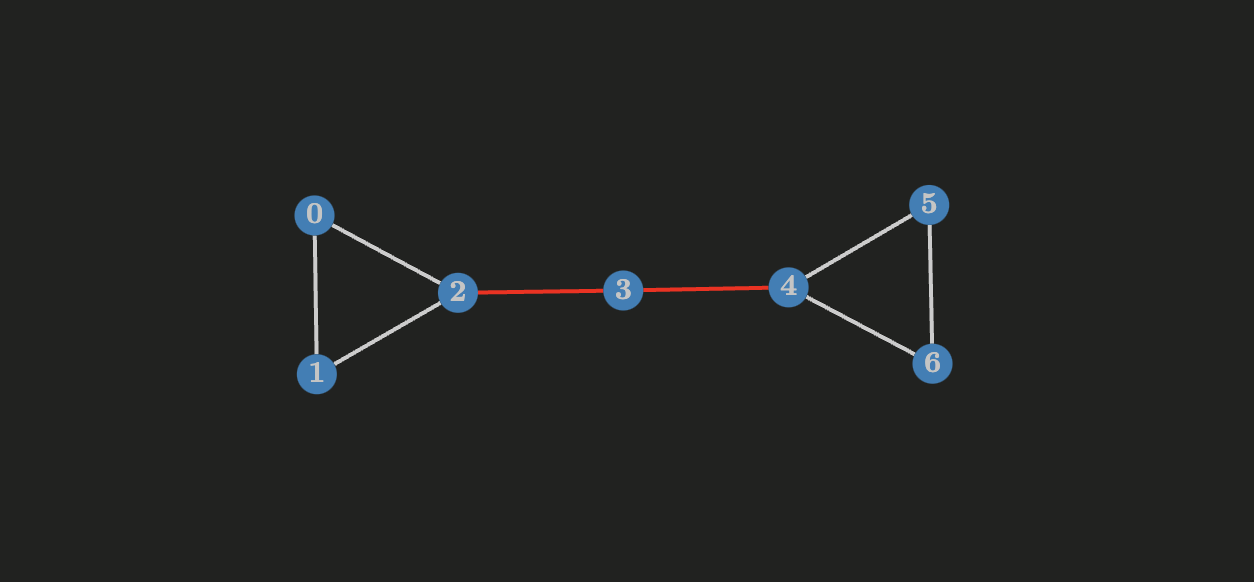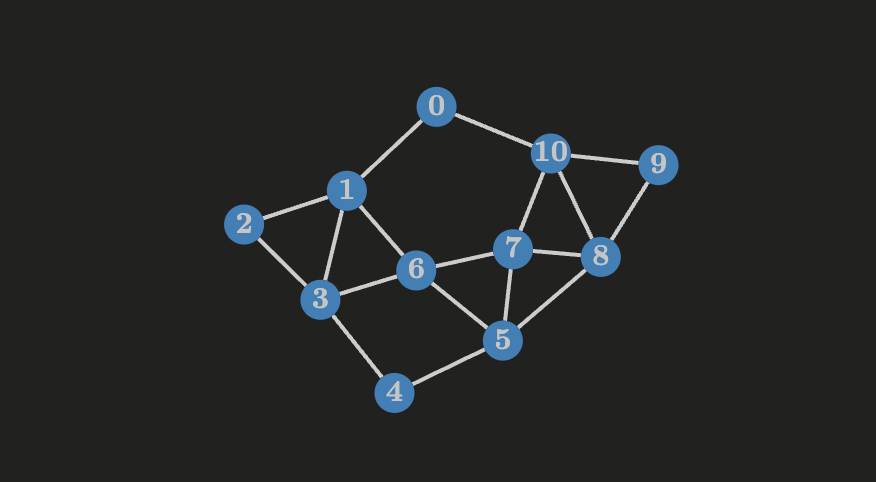All the facts/properties below are considered for an undirected connected graph
- if
- given that the order
- if
- let
Let
- a leaf vertex is not an cut-vertex
- let
- if
- let
- if
- let
int time_spent;
// the adjacency list representation of `G`
vector<vector<int> > g;
// the time a vertex `i` was discovered first
vector<int> time_in;
// stores the discovery time of the lowest predecessor that vertex `i`'s
// succesor vertices can reach **through a back edge**, initially
// the lowest predecessor is set to the vertex itself
vector<int> back;
// the articulation points found during the dfs
vector<int> cut_vertex;
void dfs(int v, int parent) {
// the lowest back edge discovery time of `v` is
// set to the discovery time of `v` initally
back[v] = time_in[v] = ++time_spent;
// count the number of children for the `root` vertex
int children = 0;
int is_cut_vertex = false;
for (int i = 0; i < g[v].size(); i += 1) {
int next = g[v][i];
if (next == parent) {
continue;
}
if (time_in[next] == -1) {
dfs(next, v);
/// if there's a back edge between a descendant of `next` and
// a predecessor of `v` then `next` will have a lower reachable
// vertex than `v` through a back edge, in this case the vertex `v` is not
// a cut-vertex (the special case of the root node is handled below)
if (back[next] >= time_in[v] && parent != -1) {
is_cut_vertex = true;
}
// propagation of the back edge to a vertex with the lowest discovery time
back[v] = min(back[v], back[next]);
++children;
} else {
// * back edge *
// update index of the vertex incident with this back edge to
// be the one with the lowest discovery time
// it's possible for this edge to be a *forward edge*, in that
// case the time won't be updated since time[v] < time[next]
back[v] = min(back[v], time_in[next]);
}
}
// the root vertex of the dfs tree is a cut-vertex
// if it has more than two children in the dfs tree
if (parent == -1 && children > 1) {
is_cut_vertex = true;
}
if (is_cut_vertex) {
cut_vertex.push_back(v);
}
}
/**
* Finds the articulation points in an undirected graph `G`
* of order`n` and size `m`
*
* Time complexity: O(n + m)
* Space complexity: O(n)
*
* @returns {int} the number of articulation points
*/
int articulation_points() {
int n = g.size();
time_spent = 0;
time_in.assign(n, -1);
back.assign(n, -1);
cut_vertex.clear();
for (int i = 0; i < n; i += 1) {
if (time_in[i] == -1) {
dfs(i, -1);
}
}
return cut_vertex.size();
}
Biconnected components in an undirected graph
A biconnected graph is a nonseparable graph meaning that if any vertex is removed the graph is still connected and therefore it doesn’t have cut-vertices
Key observations:
- two different biconnected components can’t have a common edge (but they might share a common vertex)
- a common vertex linking multiple biconnected components must be a cut-vertex of
Let
int time_spent;
// the adjacency list representation of `G`
vector<vector<int> > g;
// the time a vertex `i` was discovered first
vector<int> time_in;
// stores the discovery time of the lowest predecessor that vertex `i`'s
// succesor vertices can reach **through a back edge**, initially
// the lowest predecessor is set to the vertex itself
vector<int> back;
// the biconnected components found during the dfs
vector<vector<pair<int, int> > > bcc;
stack<pair<int, int> > edges_processed;
void output_biconnected_component(int u, int v) {
pair<int, int> top;
vector<pair<int, int> > component;
do {
top = edges_processed.top();
edges_processed.pop();
component.push_back(top);
} while (u != top.first || v != top.second);
bcc.push_back(component);
}
void dfs(int v, int parent) {
// the lowest back edge discovery time of `v` is
// set to the discovery time of `v` initally
back[v] = time_in[v] = ++time_spent;
// count the number of children for the `root` vertex
int is_cut_vertex = false;
for (int i = 0; i < g[v].size(); i += 1) {
int next = g[v][i];
if (parent == next) {
continue;
}
// mark the edge (v, next) as processed
if (time_in[next] == -1) {
// this edge is being processed right now
edges_processed.push(pair<int, int> (v, next));
dfs(next, v);
// if there's a back edge between a descendant of `next` and
// a predecessor of `v` then `next` will have a lower reachable
// vertex than `v` through a back edge, in this case the vertex `v` is not
// a cut-vertex
if (back[next] >= time_in[v]) {
output_biconnected_component(v, next);
}
// propagation of the back edge to a vertex with the lowest discovery time
back[v] = min(back[v], back[next]);
} else if (time_in[next] < time_in[v]) {
// * back edge *
// update index of the vertex incident with this back edge to
// be the one with the lowest discovery time
back[v] = min(back[v], time_in[next]);
// push this edge to the stack only once
edges_processed.push(pair<int, int> (v, next));
}
}
}
/**
* Finds the biconnected components in an undirected graph `G`
* of order`n` and size `m`
*
* Time complexity: O(n + m)
* Space complexity: O(m)
*
* @returns {int} the number of biconnected components
*/
int biconnected_components() {
int n = g.size();
time_spent = 0;
time_in.assign(n, -1);
back.assign(n, -1);
while (!edges_processed.empty()) {
edges_processed.pop();
}
bcc.clear();
for (int i = 0; i < n; i += 1) {
if (time_in[i] == -1) {
dfs(i, -1);
}
}
return bcc.size();
}
Connectivity
Let
The graph below doesn’t have a cut-vertex but it has many vertex-cut sets,
- the set with minimum cardinality is called a minimum vertex-cut set
- a connected graph
For a graph
- if
There are other measures of how connected a graph is, let
- for complete graph



